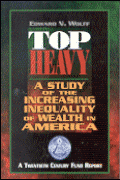What’s the latest thinking in fiscal and monetary policy? The Hutchins Roundup keeps you informed of the latest research, charts, and speeches. Want to receive the Hutchins Roundup as an email? Sign up here to get it in your inbox every Thursday.
Much of the wealth held by the richest households is accrued from business ownership
Using administrative tax data over the 2001-2016 period, Matthew Smith of the U.S. Treasury, Eric Zwick of the University of Chicago, and Owen Zidar of Princeton estimate that the top 1% of households hold as much wealth as the bottom 90%. The share of wealth held by the top 0.1% increased from 12.9% in 2001 to 15% in 2016. Households in the top 0.1% hold over half of their wealth in public equity and pass-through businesses, the authors find. In contrast, pensions and home equity make up the majority of wealth accrued by the bottom 90%. The wealthiest households also have greater risk exposure and earn higher than average rates of return on their investments, the authors estimate. Taking this heterogeneity in returns into account results in lower estimates for the share of wealth held by the top 0.1%. “Given prominent wealth tax proposals focus on the extreme tail of the wealth distribution, our estimates would reduce mechanical wealth tax revenue estimates,” the authors conclude.
Simplicity of post-FOMC press conference language gives investors additional insight
In 2011, the Federal Reserve chair began holding press conferences after Federal Open Market Committee (FOMC) meetings. Michiel De Pooter of the Federal Reserve Board finds that press conferences generate financial market reactions, suggesting that they give investors information beyond that in the post-meeting statement and Summary of Economic Projections. On average, interest rates fluctuate between 1 and 3 basis points, the S&P 500 Index changes by ½ percent, and the dollar moves around 1/4 percent during the period beginning 10 minutes before and ending 20 minutes after the press conference. The authors find that the language of the press conference is more easily understood than the FOMC statement, and also find that Chair Jay Powell’s language in answering questions has been notably less complex than that of his two predecessors. While Powell’s answers are at an eighth-grade level, Ben Bernanke and Janet Yellen’s were at the college level, according to a commonly used readability standard.
Declining interest rates disproportionately benefit “superstar” firms
Using firm-level data from 1962-2019, Thomas Kroen, Ernest Liu, and Atif Mian from Princeton and Amir Sufi from the University of Chicago find that falling interest rates disproportionately benefit “superstar” firms—those with valuations in the top 5 percent for their industry. In particular, a decline in interest rates disproportionately lowers the cost of borrowing for superstar firms, perhaps because conditions that lead to ultra-low rates tend to make other firms relatively riskier. In turn, superstar firms raise additional debt financing, repurchase shares, boost capital investment, and conduct acquisitions more aggressively than other firms. All these effects increase as the level of the interest rate approaches zero. These results suggest that the low interest rates observed in recent years may partly explain the rise of superstar firms and increase in market concentration in the U.S.
Chart of the week: Consumer price of natural gas rising quickly as winter approaches
Source: The Wall Street Journal
Quote of the week:
“I continue to believe currently elevated inflation is episodic, driven by pandemic conditions such as disruptions in supply chains and labor markets. A major caveat, though, is that the severe and pervasive supply chain issues will probably last longer than most of us initially expected. Up to now, indicators do not suggest that long-run inflation expectations are dangerously untethered. But the episodic pressures could grind on long enough to unanchor expectations,” says Rafael Bostic, President of the Atlanta Federal Reserve Bank.
“In my view, then, the fate… of price stability could be on the line in coming months. I think inflation is likely to remain above 2 percent going forward. How far forward I cannot say. But upside risks are salient. I believe the conditions I’ve described argue for a removal of the Committee’s emergency monetary policy stance, starting with the reduction of monthly asset purchases, as we discussed in last month’s meeting.”
The Brookings Institution is financed through the support of a diverse array of foundations, corporations, governments, individuals, as well as an endowment. A list of donors can be found in our annual reports published online here. The findings, interpretations, and conclusions in this report are solely those of its author(s) and are not influenced by any donation.













Commentary
Hutchins Roundup: Wealthy households, post-FOMC press conferences, and more
October 21, 2021